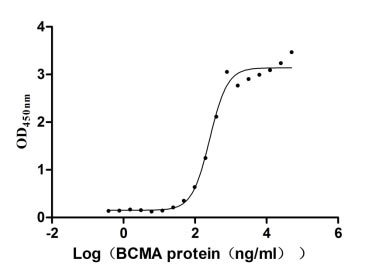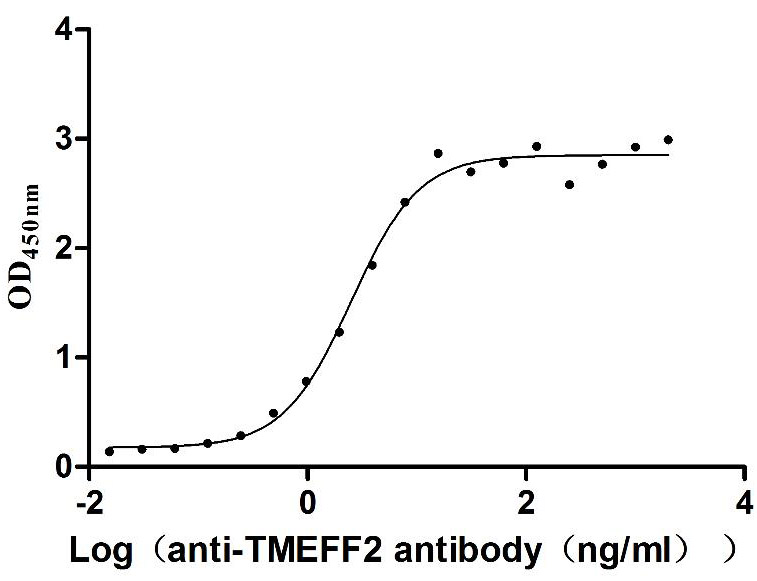Recombinant Human Transmembrane channel-like protein 1 (TMC1), partial
-
中文名称:人TMC1重组蛋白
-
货号:CSB-YP844727HU1
-
规格:
-
来源:Yeast
-
其他:
-
中文名称:人TMC1重组蛋白
-
货号:CSB-EP844727HU1
-
规格:
-
来源:E.coli
-
其他:
-
中文名称:人TMC1重组蛋白
-
货号:CSB-EP844727HU1-B
-
规格:
-
来源:E.coli
-
共轭:Avi-tag Biotinylated
E. coli biotin ligase (BirA) is highly specific in covalently attaching biotin to the 15 amino acid AviTag peptide. This recombinant protein was biotinylated in vivo by AviTag-BirA technology, which method is BriA catalyzes amide linkage between the biotin and the specific lysine of the AviTag.
-
其他:
-
中文名称:人TMC1重组蛋白
-
货号:CSB-BP844727HU1
-
规格:
-
来源:Baculovirus
-
其他:
-
中文名称:人TMC1重组蛋白
-
货号:CSB-MP844727HU1
-
规格:
-
来源:Mammalian cell
-
其他:
产品详情
-
纯度:>85% (SDS-PAGE)
-
基因名:TMC1
-
Uniprot No.:
-
别名:TMC1; Transmembrane channel-like protein 1; Transmembrane cochlear-expressed protein 1
-
种属:Homo sapiens (Human)
-
蛋白长度:Partial
-
蛋白标签:Tag type will be determined during the manufacturing process.
The tag type will be determined during production process. If you have specified tag type, please tell us and we will develop the specified tag preferentially. -
产品提供形式:Lyophilized powder
Note: We will preferentially ship the format that we have in stock, however, if you have any special requirement for the format, please remark your requirement when placing the order, we will prepare according to your demand. -
复溶:We recommend that this vial be briefly centrifuged prior to opening to bring the contents to the bottom. Please reconstitute protein in deionized sterile water to a concentration of 0.1-1.0 mg/mL.We recommend to add 5-50% of glycerol (final concentration) and aliquot for long-term storage at -20℃/-80℃. Our default final concentration of glycerol is 50%. Customers could use it as reference.
-
储存条件:Store at -20°C/-80°C upon receipt, aliquoting is necessary for mutiple use. Avoid repeated freeze-thaw cycles.
-
保质期:The shelf life is related to many factors, storage state, buffer ingredients, storage temperature and the stability of the protein itself.
Generally, the shelf life of liquid form is 6 months at -20°C/-80°C. The shelf life of lyophilized form is 12 months at -20°C/-80°C. -
货期:Delivery time may differ from different purchasing way or location, please kindly consult your local distributors for specific delivery time.Note: All of our proteins are default shipped with normal blue ice packs, if you request to ship with dry ice, please communicate with us in advance and extra fees will be charged.
-
注意事项:Repeated freezing and thawing is not recommended. Store working aliquots at 4°C for up to one week.
-
Datasheet :Please contact us to get it.
相关产品
靶点详情
-
功能:Probable ion channel required for the normal function of cochlear hair cells.
-
基因功能参考文献:
- Novel TMC1 mutation 773G>A was identified in a family with nonsyndromic hearing loss. PMID: 29692870
- the whole exome sequencing (WES) in this family revealed two homozygous variants in EVC2 (c.30dupC; p.Thr11Hisfs*45) and TMC1 (c.1696-1G>A) genes. In family B, WES revealed novel compound heterozygous variants (p.Ser307Pro, c.2894+3A>G) in the EVC gene. PMID: 29321360
- Pathogenic variations in the TMC1 gene (encoding the transmembrane channel-like protein 1) are found in more than a third of hearing-impaired Jewish patients of Moroccan ancestry. PMID: 28821934
- the identification of a previously identified c.100C>T mutation, and a novel homozygous mutation, c.1283C>A in TMC1, in this study supports TMC1 gene as one of the second-tier hearing loss genes, after GJB2 in India. Testing for TMC1 may be considered in all GJB2-negative nonsyndromic hearing loss cases PMID: 28862181
- two novel mutations in the WHRN and TMC1 genes are responsible for founder effects of hereditary hemochromatosis, Wilson s disease, the long QT syndrome and autosomal recessive deafness in a Swedish pedigree PMID: 29270100
- But the great majority of evidence is consistent with these TMCs as pore-forming subunits of the long-sought hair-cell transduction channel. [review] PMID: 27798174
- a novel TMC1 mutation in exon 20, c.1979C>T, p.P660L, which segregated with prelingual autosomal recessive sensorineural hearing loss, was found. PMID: 26822030
- there is hypo-functional TMC1 mechanotransduction channel activity and other even less damaging variants of TMC1 may be associated with more common mild-to-severe sensorineural hearing loss. PMID: 26879195
- TMC1 has been identified as the causative gene in a six-generation Chinese family with autosomal dominant hearing loss. PMID: 26079994
- The first mutation in the TMC1 gene in the Moroccan population causing non-syndromic hearing loss. PMID: 26226225
- The novel compound heterozygous mutant alleles of TMC1 identified in this study were responsible for the autosomal recessive non-syndromic hearing loss in this Tibetan Chinese family. PMID: 25458163
- one heterozygous, non-synonymous variant was detected, with the SNP causing an amino acid substitution in TMC1 in a Polish family with hearing impairment PMID: 25560804
- Co-segregation of c.2030T>C mutation with hearing loss in an Iranian family and absence of this mutation in 100 Iranian controls confirms the pathogenicity of this mutation. PMID: 25423259
- TMC1 mutations disrupt hair cell mechanoelectrical transduction and are responsible for DFNA36 and DFNB7/B11. [Review Article] PMID: 24933710
- TMC1 is expressed in the hair cells in inner ear. PMID: 24827932
- Description of the spectrum of mutations in TMC1 in 374 families with autosomal recessive, non-syndromic hearing loss from India. PMID: 24416283
- hearing loss in this family was caused by novel compound heterozygous mutations in TMC1 PMID: 23690975
- DNA sequencing of all coding and non-coding exons and intron boundaries of the TMC1 gene identified c.-258A>C mutation in non-coding exon 3 only in individuals from two ethnically related Iranian with hearing loss. PMID: 23523375
- A single founder mutation, c.100C>T (p.Arg34X) that dominates the TMC1 mutation spectrum is not a significant cause of deafness in British Aasians. PMID: 22288896
- A novel homozygous A-to-G change in the TMC1 gene was detected near the splice donor site of intron 19 (c.1763+3A-->G) segregating with the hearing loss in a Dutch family PMID: 21252500
- DFNB7/11 is a common form of genetic hearing loss in Iran, because this population is the source of 6 of the 29 TMC1 mutations reported worldwide PMID: 21250555
- Our study shows that the p.R34X mutation in TMC1 in North African and Asian individuals arose from at least two different founders. PMID: 20373850
- A novel dominant mutation, p.G417R, and a novel recessive mutation, p.N50KfsX26, in TMC1 in a large Iranian DFNA36 family (Family L1754 ) and a consanguineous Iranian DFNB7/11 family (Family L787), respectively, were identified. PMID: 20447146
- The p.D572N mutation of TMC1 co-segregating with hearing loss in a North American family, was studied. PMID: 19180119
- role of mutations causing dominant and recessive deafness PMID: 11850618
- TMC1 mutations account for at least 6% (4/65) of ARNSHL in GJB2-negative Turkish families from the northeast and east of Turkey. PMID: 16287143
- 9 different TMC1 mutations account for deafness in 19 (3.4%) of the 557 Pakistani families. A single mutation, p.R34X, causes deafness in 10 (1.8%) of the families. PMID: 17877751
- This study confirms that mutations in the TMC1 gene may be a common cause for autosomal recessive nonsyndromic HI. PMID: 18259073
- linkage to DFNA36 and DFNB7/11 in 1 family with dominant and 10 families with recessive non-syndromic sensorineural hearing loss. In addition, mutation analysis of TMC1 PMID: 18616530
- Mutaions in TMC1 contribute significantly to nonsyndromic autosomal recessive sensorineural hearing loss. PMID: 19187973
收起更多
-
相关疾病:Deafness, autosomal dominant, 36 (DFNA36); Deafness, autosomal recessive, 7 (DFNB7)
-
亚细胞定位:Cell membrane; Multi-pass membrane protein.
-
蛋白家族:TMC family
-
组织特异性:Detected in fetal cochlea, and at low levels in placenta and testis.
-
数据库链接:
HGNC: 16513
OMIM: 600974
KEGG: hsa:117531
STRING: 9606.ENSP00000297784
UniGene: Hs.670211




-AC1.jpg)
-AC1.jpg)














